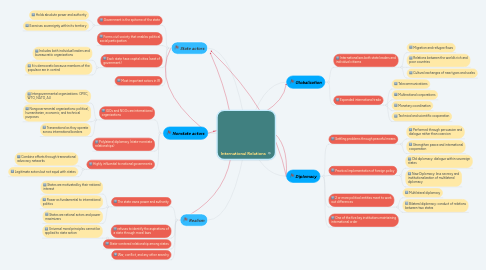
1. State actors
1.1. Government is the epitome of the state
1.1.1. Holds absolute power and authority
1.1.2. Exercises sovereignty within its territory
1.2. Forms civil society that enables political social participation
1.3. Each state have capital cities (seat of government)
1.3.1. Includes both individual leaders and bureaucratic organizations
1.3.2. It is democratic because members of the populace are in control
1.4. Most important actors in IR
2. Nonstate actors
2.1. IGOs and NGOs are international organizations
2.1.1. Intergovernmental organizations: OPEC, WTO, NATO, AU
2.1.2. Nongovernmental organizations: political, humanitarian, economic, and technical purposes
2.1.3. Transnational as they operate across international borders
2.2. Polylateral diplomacy (state-nonstate relationships)
2.3. Highly influential to national governments
2.3.1. Combine efforts through transnational advocacy networks
2.3.2. Legitimate actors but not equal with states
3. Realism
3.1. The state owns power and authority
3.1.1. States are motivated by their national interest
3.1.2. Power as fundamental to international politics
3.1.3. States are rational actors and power maximizers
3.2. refuses to identify the aspirations of a state through moral laws
3.2.1. Universal moral principles cannot be applied to state action
3.3. State-centered relationship among states
3.4. War, conflict, and any other anarchy
4. Globalization
4.1. Internationalizes both state leaders and individual citizens
4.1.1. Migration and refugee flows
4.1.2. Relations between the world’s rich and poor countries
4.1.3. Cultural exchanges of new types and scales
4.2. Expanded international trade
4.2.1. Telecommunications
4.2.2. Multinational corporations
4.2.3. Monetary coordination
4.2.4. Technical and scientific cooperation
5. Diplomacy
5.1. Settling problems through peaceful means
5.1.1. Performed through persuasion and dialogue rather than coercion
5.1.2. Strengthen peace and international cooperation
5.2. Practical implementation of foreign policy
5.2.1. Old diplomacy: dialogue within sovereign states
5.2.2. New Diplomacy: less secrecy and institutionalization of multilateral diplomacy
5.3. 2 or more political entities meet to work out differences
5.3.1. Multilateral diplomacy
5.3.2. Bilateral diplomacy: conduct of relations between two states
